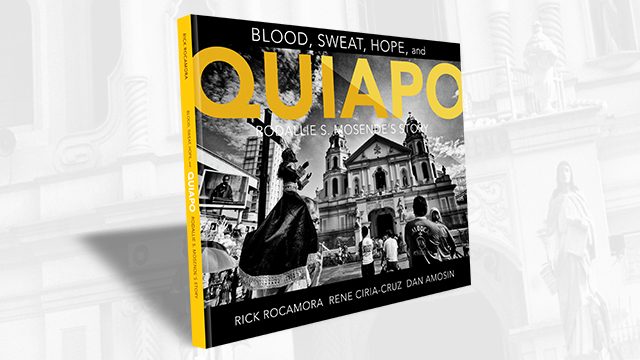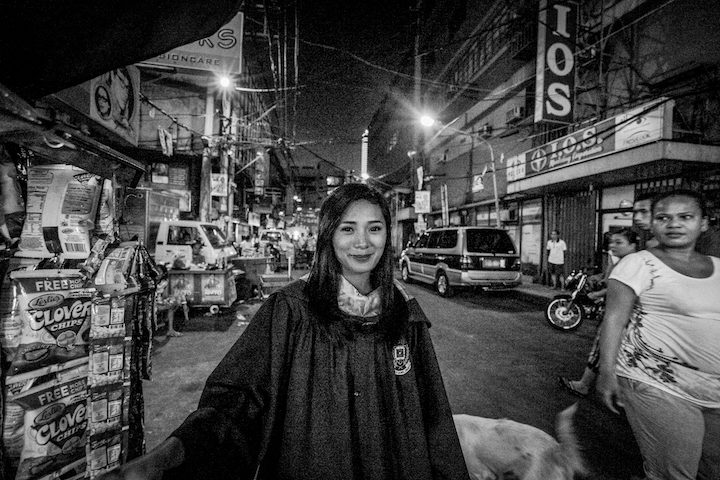SUMMARY
This is AI generated summarization, which may have errors. For context, always refer to the full article.

This is from a press release on the book.
MANILA, Philippines – “Blood, Sweat, Hope and Quiapo – Rodallie S. Mosende’s Story” will be launched on Thursday, April 28, at 6 pm at the Filipinas Heritage Library, Ayala Museum, Makati.
The photographs are by Rick Rocamora, foreword by Rene Ciria-Cruz, and essay by Dan Amosin. The coffee table book was designed by Ben Molina, and Black and White images printed in tritone by CGK formaprint.
Rodallie S. Mosende grew up homeless since birth on Paterno Street, Quiapo, Manila, Philippines.
She was a child beggar at a time, grabbing food from strangers when hungry, and hustling for vegetables and meat from vendors when her mother was sick, promising to pay them back when she got older.
She was a street sweeper until her sophomore year in college to earn extra money for transportation and food.
Being poor and living on the street, coping with classroom requirements requires a different set of skills. She learned to study using candles, streetlights, and while in college, staying late to use the library, its computers and printers to finish her assigned work.
Because of documentary photographer Rick Rocamora’s practice of sharing his visual stories of his subject with anyone who would like to take a look, a benefactor who insists on remaining anonymous offered to support Rodallie’s college education with a monthly stipend to cover her other expenses.
While they now have a small rented room, Rodallie continues to sleep on the street to accompany her mother watching her merchandise and vending stall.
Rodallie also serves as a tutor to other school kids who live on Paterno Street, and a role model for street children.
Rodallie, now 22 years old, graduated on April 23, 2016, with a degree of Bachelor of Science in International Hospitality Management and a specialization in cruise line operation in hotel services from Lyceum University of the Philippines, Manila Campus at PICC in Manila. (READ: From street child to Atenean: The story of Rusty)
With a future job in the cruise industry waiting for her after graduation, she will have a comfortable place to sleep and the amenities of a home for the first time.
Hopefully she would be able to earn enough to lift herself and her family out of poverty.
Rodallie is an inspiration to many Filipinos, a great example of survival against difficult odds in life.

Rick Rocamora on Rodallie’s story
Five years ago, I started visiting Quiapo with more frequency, intent on documenting the heart and soul of its residents once described by noted writer Jose “Pete’ Lacaba, as the Armpit of the Nation. (READ: Life’s arcade: Quiapo)
Poverty is written all over Quiapo; it’s one side of the divide between rich and poor that fractures Metro Manila. The streets are overcrowded and navigating them is an acquired skill. While the area is well known for the availability of hard-to-find goods, repairmen, and food ingredients, many fear shopping there.
During the Feast of Black Nazarene, instead of focusing on the procession, I directed my attention to events happening on the side streets away from the armada of photographers that descends on Quiapo during the fiesta every year.
To find the truth and educate others, I dug deeper into the lives of my subjects in Quiapo, learning each of their life histories, challenges and anxieties. I also worked hard to find unique voices among the residents and frequent visitors to the district.
The real story of Quiapo is not about crime and filth. Those in the know see Quiapo in a different light: as a haven for strong-hearted, hardworking individuals tenaciously trying to overcome life’s obstacles for their dreams.
I hope that you find inspiration from the images and stories of these ordinary Filipinos who are determined to make life better for themselves and their families. I did.
About Rick Rocamora
Rick Rocamora is an award-winning documentary photographer who has dedicated himself documenting issues about civil liberties, immigrant rights and their contributions in the US, human rights and social justice issues in the Philippines.
He is the author of Filipino WWII Soldiers – America’s Second-Class Veterans, for which he was awarded a Local Bay Area Heroes award by KQED and Union Bank of California.
His work is part of the permanent collection of San Francisco Museum of Modern Arts, U.S. State Department Art in Embassies program, and private and institutional collectors. His work is widely exhibited in national and international museums and galleries and published in print and online.
In the Philippines, his work had been exhibited at the Cultural Center of the Philippines, Vargas Museum, Ben Cab Museum, University of the Philippines, Ateneo de Manila University and the halls of the Senate of the Philippines. – Rappler.com
Add a comment
How does this make you feel?
There are no comments yet. Add your comment to start the conversation.